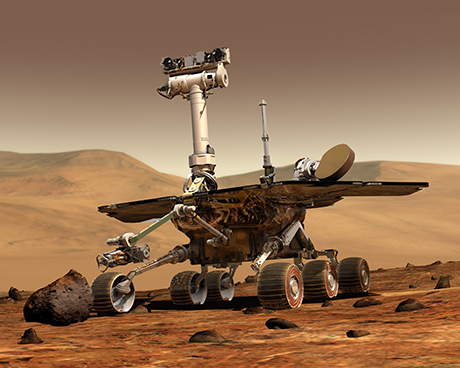Is sending humans to Mars within the next two decades a feasible goal?
“Absolutely,” said Chris Carberry, executive director of nonprofit organization Explore Mars. And soaring beyond the stars will not be nearly as difficult—or as costly—as one might think.
Aerospace leaders, policymakers, scientists and students will convene at the George Washington University from Tuesday through Thursday for the annual Humans to Mars Summit (Humans2Mars), sponsored by Explore Mars and GW’s Space Policy Institute in the Elliott School of International Affairs.
“We need to find a way to build a program that is able to last through many congressional terms.”
Chris Carberry, executive director of Explore Mars
Panel discussions and keynote speeches over the three-day summit will explore the feasibility and affordability of sending humans to Mars by year 2030. Day one of the conference, held in Lisner Auditorium on Tuesday, will be free for GW students and STEM educators, who can register here. Speakers will include NASA Administrator Charles F. Bolden Jr., President and CEO of the Council on Competitiveness Deborah L. Wince-Smith and Buzz Aldrin, the second man to walk on the moon, among many others.
“The main goal of the summit is to build excitement among the students to find a policy direction, but also to try and dispel myths that this is going to be some ridiculously expensive project that will put us further into national debt,” Mr. Carberry said. “That belief tends to gain traction when there isn’t enough education.”
The GW community will also be able to get up close and personal with a model of the Mars Rover, when it arrives on campus on Monday. The model, about the size of a small SUV, will be housed in the atrium of the Marvin Center throughout the week of April 21.
During the first day of the conference, Director of GW’s Space Policy Institute Scott Pace will moderate a panel on how GW is examining and evaluating options for the future in space—featuring Professors Henry Hertzfeld and Pascale Ehrenfreund from the Space Policy Institute; Assistant Professor in the School of Engineering and Applied Science Zoe Szajnfarber; and Kris Lehnhardt, assistant professor in the School of Medicine and Health Sciences.
Mr. Carberry said that getting humans to Mars 20 years from now is a “policy problem” rather than a scientific one.
“We need to find a way to build a program that is able to last through many congressional terms,” he said.
The primary policy challenge, according to Dr. Pace, is how to link such a mission to broader U.S. national interests and the interests of other countries in a way that is politically sustainable across decades.
NASA Associate Administrator William Gerstenmaier (who will be involved in the Humans2Mars Summit) outlined NASA’s plans for future space exploration last week during testimony before the Senate Commerce Subcommittee on Science and Space.
The hearing, called “From Here to Mars,” highlighted a possible mission to send a manned spacecraft to a near-Earth asteroid. The mission would also require using robotic technology to redirect the meteorite into an orbit around the moon in order to collect samples from it.
Mr. Gerstenmaier said that while it may not be as flashy as a manned expedition to Mars, (which NASA still has in the works for year 2030), it could get the public reinvigorated about space exploration, according to the Huffington Post.
A space mission to Mars, Mr. Carberry said, could really capture the public imagination, helping to solve the United States’ “confidence problem,” and maybe even boost the country’s economy.
“We keep trying to convince ourselves that we’re falling behind in everything—and some things we are, some things we’re not. But we’ll continue that trend if we stop funding things like NASA,” he said. “And so, when we think that we are doing great things, that can really stimulate the country in other ways than just going to Mars.”


